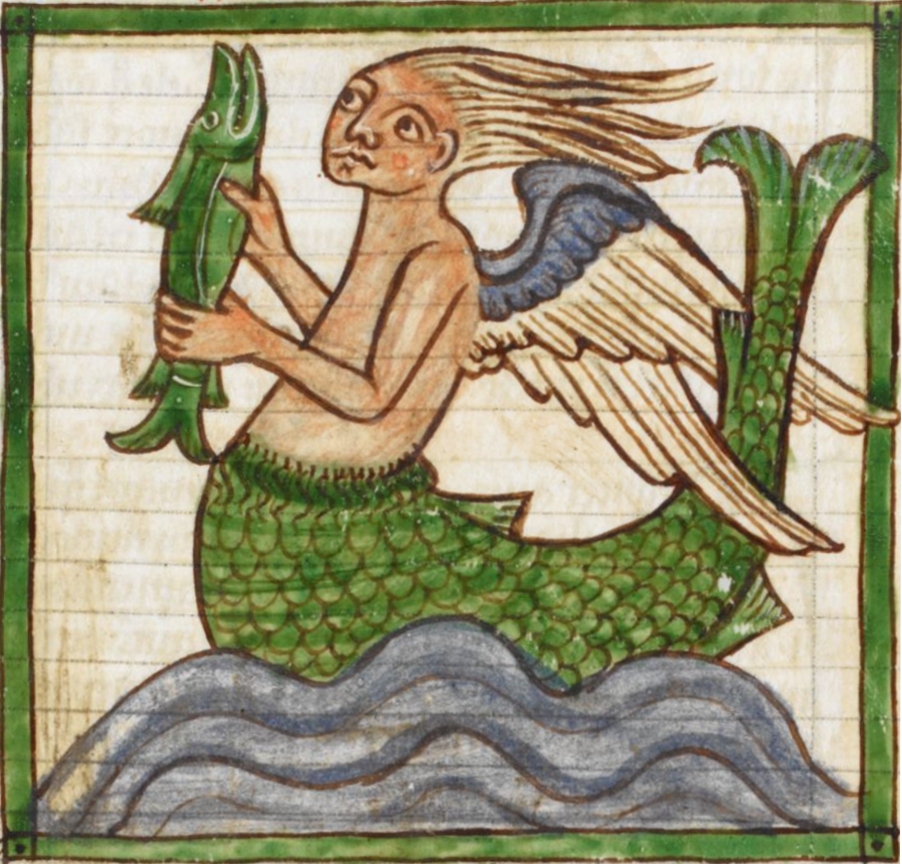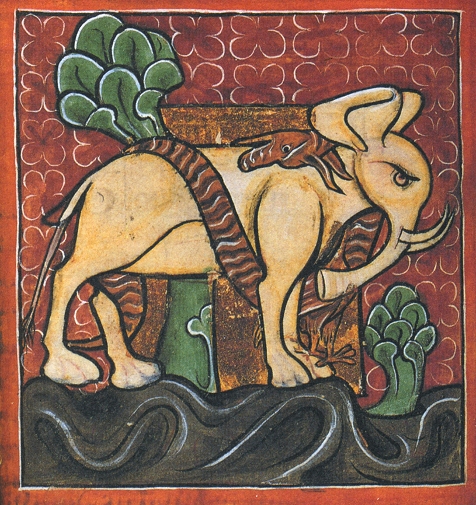Fabulous Beasts in Myth & Legend
N - Z
- Nix or Nixie
- The nix was a water-sprite, treacherous to men. The female was siren-like, beautiful and sometimes fish-tailed, and lured men to drown: the male was usually old and dwarfish but sometimes appeared as a golden-haired boy. Another variety of nixies was more elfin; they occasionally appeared as wives in the market, betrayed by the wet edge of their aprons. If they paid well, everything would be expensive that year; if badly, goods would be cheap. Both sometimes married humans, but the result was always tragic.
- Nuckelavee
- Centaur-like Irish sea monster with breath that brought plague. The only way to escape from it was to cross running water.
- Padfoot
- A demon dog said to haunt the countryside near Leeds.
- Peg Powler
- A nixie found in the River Tees. Like others of her kind she had green hair and was insatiable for human life. The foam on the upper reaches of the river was called 'Peg Powler's suds'.
- Peist
- Irish dragon imprisoned by St Patrick.
- Picktree Brag
- A Durham version of the bogey. Its usual forms were animal, but it sometimes appeared as a headless naked man.
- Pooka
- A wild shaggy colt hung with chains which haunted wild places, and misled travelers. Related in its mischievous habits to the hobgoblin Puck which has become a household spirit. Also called Phooka, or in Welsh, Pwca.
- Portunes
- Gervase of Tilbury in the twelfth century reported that these creatures went about English farmhouse in hoops. They were dwarf-like, with small wrinkled faces. Their only form of mischief was to mislead horsemen.
- Rawhead
- A pond spirit or Nix found in Northern England, also known as Bloody Bones; it dragged children into its lair and drowned them. It was this spirit, recorded as early as the fifteenth century, which gave its name to the pirate flag of skull and crossbones.
- Redcap
- An evil spirit in the shape of a squat old man with long nails and a red cap dyed in the blood of its victims who haunted the peel towers along the Scottish borders. It attacked humans, but could be drive off by quoting the Bible or by the sight of the cross in the shape of a sword-handle. The redcap at Grandly Castle, Prettier was of a different kind, and was regarded as lucky.
- Saint Attracta's Monster
- An Irish beast which roared like a lion, had boar's tusks, fiery eyes and ram's ears. The saint made the sign of the cross over him with her staff and he fell dead.
- Saint Senan's Monster
- A creature which lived on the island of Iniscathy, banished by St Senan. It was amphibious with a horse's mane, fiery breath, and a whale's tail. It had one eye in its forehead, and it struck fire from the rocks with its iron nails.
- Shony
- A Cornish ghost-dog whose appearance heralded a storm.
- Side
- A fairy race of Ireland, often called Tuatha de Danaan.
- Spriggan
- Ghosts of giants which haunted megaliths and standing stones, guarding the treasure buried there. They could swell to a huge grotesque shape or shrink to a small size. They were to blame for all kinds of disasters, such as falling buildings, bad weather or lost children.
- Tangie
- A demonic seahorse owned by Black Eric who lived in a cave in the side of Fitful Head, Shetland Islands, Scotland. Black Eric rode out on Tangie to raid and harass the surrounding crofts. The cave is still known as the Thief's Hole. After a time, a courageous crofter, Sandy Breamer, had enough of Black Eric and cornered him at the top of the Head. Black Eric fell to his death in the sea, but Tangie continued to terrorize the district for awhile in his attempts to secure a mortal bride.
- Twrch Trywth
- A boar who had once been a king, but had been transformed by God as a punishment. The comb and shears which he carried between his ears were needed so the giant Ysbaddaden could prepare himself for the wedding of his daughter Olwen to the hero Culhwch. Arthur, accompanied by his warriors and Mabon mab Modron and Gwyn ap Nudd, chased it across Ireland, Wales and Cornwall. It finally disappeared into the sea off the Cornish coast, but the comb and shears had already been stolen from it.
- Uilbheist
- A Gaelic sea serpent with several heads.
- Urisk
- A shaggy, satyr-like spirit who haunted deserted places in the Highlands, especially waterfalls. He helped farmers and was a kind of familiar spirit of farmsteads driven into the wild by Christianity. They would follow and terrify lonely travelers at night, but were harmless. They were said to meet occasionally in great assemblies.
- Water-Bull
- A small, black, creature, soft and slippery, in appearance like a bull, which lived in lonely Scottish lochs. It mated with ordinary cattle, and its offspring had short ears.
- Water-Horse, Kelpie or Nykur
- Grey or black horse whose hooves pointed backwards. It could change shape at will; if it mated with an ordinary horse its offspring would always lie down in the water when crossing fords. It led men astray by enticing them to ride it across a river. If Christ's name was mentioned, the rider was dropped in the water. See also Boobrie.
- Wild Huntsman
- The giant figure of Herne the Hunter, with a deer's head and antlers, was supposed to roam Windsor Park. He was probably a vague memory of a pagan deity.
There is an old tale goes that Herne the hunter,
Sometime a keeper here in Windsor Forest,
Doth all the winter-time, at still midnight,
walk round about an oak, with great ragg'd horns,
And there he blasts the tree, and takes the cattle,
And makes milch-kine yield blood,
and shakes a chain
In a most hideous and dreadful manner.
(The Merry Wives of Windsor, William Shakespeare)
Herne is traced by some, both as to name and as to his 'great ragg'd horns' to the Celtic god Cernunnos, who is usually shown sitting cross-legged and wearing antlers.
- Wodewoses or Wild Men
- These forest creatures usually depicted as men with shaggy green hair all over their body, carrying clubs, are found as supporters in many coats of arms. In medieval times they were supposed to be semi-human beings who could not speak and were unable to control themselves when angry or lustful. It has been suggested that they were originally men suffering from a rare skin disease which causes a fur-like growth on the body; but they are more likely to be survivals from pagan beliefs. They abduct women and devour children, especially unbaptized children. Some wild men are one-eyed, and others are deformed ogres.
- Ysgithyrwyn
- A great boar pursued by Arthur in order to procure his tusk, so that the giant Ysbaddaden could shave with it before the wedding of his daughter Olwen to the hero Culhwch. See also Twrch Trywth.
Photo credits: (Related Resources) (1) Harley MS 3244, British Library Digitised Manuscripts, PD-Art, Wikimedia Commons, (2) MS Body 764, Bodleian Library, Oxford, England, PD-Art, Wikimedia Commons

